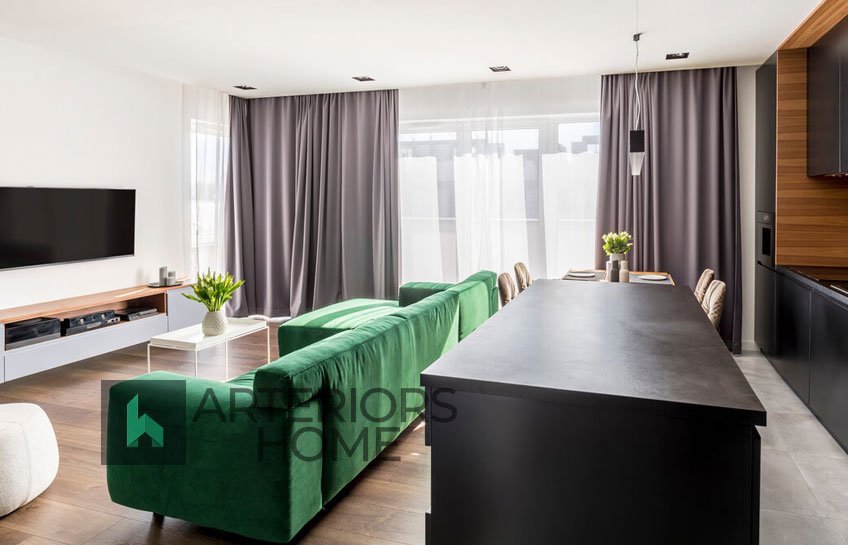Color plays a vital role in shaping the atmosphere and perception of hospitality spaces. The strategic use of color in hotels, restaurants, and other hospitality venues can significantly enhance the guest experience.
This article will explore the psychology of color, emerging color trends, and practical applications of color theory in hospitality design. Discover how the thoughtful implementation of color can help hospitality businesses boost customer satisfaction, increase brand recall, and gain a competitive edge.
Introduction
The colors incorporated into the physical space of hotels, restaurants, and other hospitality venues have a profound impact on the customer experience. From stimulating appetite in a restaurant to evoking a sense of tranquility in a hotel lobby, color strongly influences people’s emotions and behaviors. As such, the strategic selection and application of color is a important design consideration for hospitality professionals.
The Importance of Color in Hospitality
Research has shown that the human brain responds differently to different wavelengths of light. Colors can evoke powerful psychological and physiological reactions. In hospitality settings, color can be used to increase comfort, improve wayfinding, and communicate brand identity. The appropriate use of color creates positive first impressions and enhances the overall atmosphere.
Maximizing the Impact of Color
A thoughtful, research-backed approach to color in hospitality design is essential. Factors like color harmony, cultural associations, location, and target demographic need to be weighed. Impactful use of color aligns the needs of the business with human psychology and perception. This helps shape positive guest experiences that boost satisfaction, reviews, and repeat visits.
A Strategic Advantage
The data-driven, purposeful application of color gives hospitality businesses a distinct competitive edge. Color can improve the efficiency of operations, heighten enjoyment of amenities, and deepen the customer’s connection to the brand. By leveraging the strategic power of color, hospitality design can play a major role in business success.
The Psychology of Color
Color choice in hospitality design should align with the desired psychological responses and brand messaging. An understanding of color psychology ensures colors elicit the appropriate emotional states and behaviors from guests.
Color and Human Emotion
Certain colors trigger specific emotional and physiological reactions in people, often on a subconscious level. These effects are rooted in learned cultural associations and innate biological responses. Strategically using colors with calming, energizing, or appetizing associations enhances the guest experience.
- Blue evokes feelings of tranquility and security
- Green promotes relaxation and harmony
- Yellow stimulates cheer and optimism
- Red incites excitement, passion, and appetite
- Purple inspires creativity and sophistication
- Orange boosts enthusiasm and sociability
Influencing Behaviors and Decisions
Beyond emotions, color influences human decision making and behaviors like:
- Appetite – Red and yellow can stimulate hunger, while blue suppresses it.
- Alertness – Blue boosts alertness and perception of time versus red.
- Impulse control – Blue promotes patience and accuracy versus red.
- Risk-taking – Red and black increase risk-taking behaviors.
- Wayfinding – Vibrant colors aid navigation versus muted shades.
These responses allow hospitality businesses to strategically guide guests towards certain actions through purposeful and consistent use of color.
Successful Examples
- Fast food chains often use red in branding to spark appetite and energy.
- Casual dining spots may opt for orange to evoke cheer and social connection.
- Luxury retreats frequently utilize blue and green to create peaceful sanctuary spaces.
Color Trends in the Hospitality Industry
Like all design elements, color preferences and trends within hospitality are continually evolving. Tracking emerging trends allows businesses to keep their spaces looking fresh, current, and appealing.
Factors Influencing Trends
Many cultural and demographic factors shape popular colors in hospitality interiors, including:
- Generation – Youthful generations like Millennials and Gen Z drive preferences for vibrant, bold colors that represent newness and innovation. Baby Boomers tend to favor more neutral, traditional color schemes.
- Location – Regional tastes drive localized color trends. Bold tones suit urban properties while subdued hues fit better in natural, rural settings.
- Purpose – A family-friendly pizzeria benefits from bright, playful colors versus the sleek monochromatic style of a couple’s retreat.
- Technology – Advancements like LED lighting allow for dynamic color schemes versus static paint colors.
Current Leading Trends
Some top color trends gaining traction in hospitality currently include:
- Neutral earth tones like light tans, creams, and greys, often punctuated with natural wood and stone accents.
- Rich jewel tones like emerald green, ruby red, and sapphire blue, sometimes combined with metallic sheens.
- Contrasting bright and muted accent shades like vivid orange chairs against neutral walls and flooring.
- Retro-inspired colors like mustard yellow, avocado green, and burnt orange.
Adaptability is Key
Since color appeal evolves quickly, hospitality businesses should view color schemes as adaptable rather than permanent. As trends fade or new needs emerge, spaces can be reinvented with fresh coats of paint, replaced textiles, or updated lighting.
Using Color to Create Ambiance
One of the most powerful applications of strategic color is in shaping the look, feel, and ambiance of hospitality interiors. Purposeful choices harmonize with and enhance the venue’s atmosphere.
Aligning with the Desired Environment
Consider the setting and emotions the space should evoke, then select colors that logically coordinate. For example:
- Energizing workspace: Opt for stimulating shades like lemon yellow or lime green
- Serene spa: Feature calming hues like light blue or sage green
- Luxurious hotel: Incorporate rich tones like navy, maroon, and metallic accents
Color Temperature Impacts Mood
Warm colors like red, orange, and yellow feel energizing and cozy. Cool colors of blue, violet, and green are calming and refreshing. Choosing appropriate temperatures is key.
Lighting and Perception
Color can alter the perception of natural and artificial light. Dark walls make spaces feel smaller and more intimate while light walls create an airy, open feeling. Bright lighting makes colors seem more vibrant.
Cohesive Palettes
Carefully curated color schemes that logically flow from one space to another cultivate holistic ambiance. If executed inconsistently, disjointed colors disrupt, rather than enhance, the environment.
Color and Branding in Hospitality
In hospitality, recognizing how color reinforces branding is pivotal. Strategic use of color consistently communicates and supports brand identity.
Brand Identity Through Color
A brand’s visual identity guidelines often dictate signature color palettes. Marriott hotels ubiquitously feature shades of red, Hilton utilizes blue, and Best Western centers on blue and yellow. Integrating brand colors strengthens consumer recognition and loyalty.
Reflecting Brand Values
Colors also represent less tangible brand values, attributes, and personality:
- Blues suggest trusted, secure, and dependable service.
- Greens speak to natural, healthful, and peaceful hospitality.
- Oranges and yellows feel welcoming, friendly, and energetic.
Consistent Messaging
Brand colors applied consistently in logos, exterior signage, website design, interiors, staff uniforms, marketing materials, and more cohesively communication. Deviating from guidelines dilutes and confuses branding.
Subtle Signatures
Occasional subtle splashes of brand colors used in textiles, artwork, or architectural details further boost identification without overwhelming design.
Practical Applications of Color Theory
How can hospitality professionals translate general color theory and psychological understanding into actionable design practices? Follow these tips for effectively applying color.
Choosing Color Palettes
Use an appropriate main color as a base, then build upon it:
- Public spaces: Opt for versatile neutral main shades then layer in pops of brighter accent colors as needed
- Guest rooms: Select a rich brand or trending main color that relates to the target mood, like blue for relaxing
- Food and beverage: Pick appetite-appealing yellow, orange, or red tones for dining rooms
Guiding the Journey
Paint hallways and passageways in progressively lighter or darker shades as guests move toward their destination to support wayfinding.
Calling Attention
Apply bold or contrasting colors to highlight architectural features, seating areas, food stations, or other points of interest.
Brand Integration
Work brand colors into prints and patterns on soft furnishings like pillows, linens, and curtains.
Consistent Color Identity
Maintain a cohesive feel by choosing complimentary paint, fabric, furniture finishes, and decor colors.
Overcoming Challenges in Color Implementation
While strategic color use clearly positively impacts hospitality design, some challenges around subjectivity, logistics, and sensitivities can arise. Proactive planning minimizes any issues.
Perceptual Differences
Since color appeal is personal, bold or unusual color choices won’t please every customer. Market research and focus groups help avoid subjectivity pitfalls. Offering multiple color schemes via changeable accents also mitigates this issue.
Cultural Sensitivities
Some colors carry negative meanings in certain cultures that must be considered, like white symbolizing death in some Asian cultures. again, market testing is critical to avoid unintended associations.
Transitioning Multi-Use Spaces
Spaces like ballrooms or conference centers warrant adaptable color. Install color-changing LED light fixtures or removable colored window films to transform environments.
Cost Control
Limit costly painting or replacements by selecting most fixed elements like flooring or tiles in versatile neutrals, then use less permanent accents like tablecloths for pops of color.
Maintenance
Dark or saturated colors show wear, stains, and damage more readily than lighter subtler hues. Choosing the right balance of aesthetics and practical maintainability prevents issues.
The Future of Color in Hospitality Design
As hospitality color trends and technologies evolve, new possibilities for creating meaningful branded experiences emerge. The future holds exciting innovations in dynamic, personalized color applications.
Shifting Color Preferences
Generation Z and Millennials will likely drive increased preference for bold, daring, and unconventional color combinations with global influences. More niche boutique properties catering to younger generations could push the color envelope further.
Technical Advances
New color-changing, remote controlled LED lighting allows hospitality businesses to adjust color schemes in a moment for different uses or moods. Smart textiles and surfaces responding to environmental stimuli also enable more dynamic, customizable color palettes.
Personalized Experiences
Hyper-customized guest experiences are a top hospitality trend, and color provides new avenues for personalization. Guests could select preferred colors for their spaces, or dynamic color could respond to individual biometric data to support wellness.
Immersive Environments
Panoramic digital displays, projection mapping, and AR technology allow hospitality businesses to immerse guests in almost any imaginable visual experience using color, taking brand theming and environmental storytelling to new heights.
Conclusion
Color selection drastically impacts hospitality environments and should not be an afterthought. When strategically implemented, thoughtful color palettes enhance branding, shape guest experiences, communicate meaning, and drive revenue in measurable ways. By harnessing the psychology of color along with current trends and innovations, hospitality professionals can leverage color as a critical tool in designing memorable, meaningful branded spaces that delight customers.
The data-driven application of color creates competitive advantage and reimagines possibilities within hospitality environments. However, technical knowledge must be balanced with human-centric design thinking. Guests’ needs and responses should remain at the center of any color strategy. When hospitality professionals tap into the visual language and power of color, they create welcoming experiences that resonate authentically.




No Comment! Be the first one.